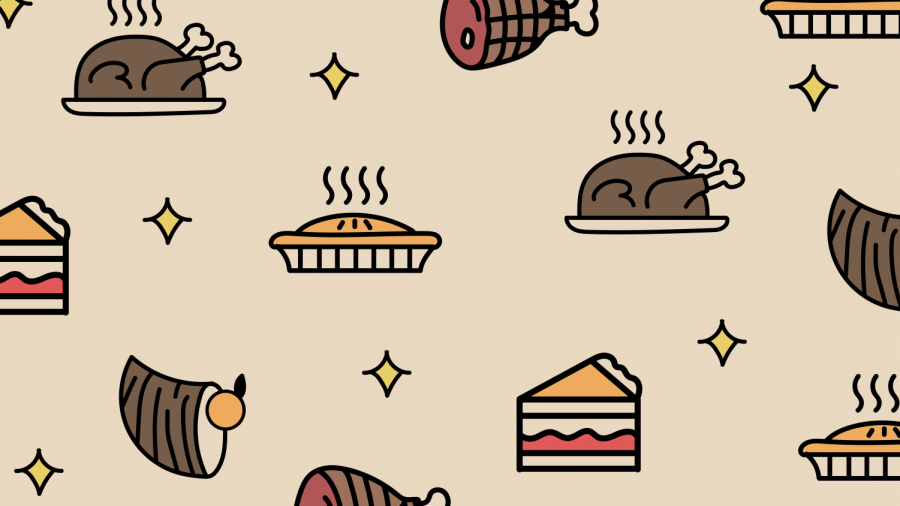A tale of 2 ‘regions’: How Thanksgiving foods differ from north to south
November 27, 2019
‘Tis the season for wonderful smells wafting from the kitchen and delicious food spread out for the taking. Whatever holiday you celebrate, you likely have foods that are special to your family. But how different are your holiday foods based on what part of the country you live in?
‘From the North’ by Kelley Holland
When I moved to Bowling Green from Connecticut five years ago, I expected there would be obvious differences in culture. However, there was something I never gave much thought: holiday foods.
You can call it ignorance, but for most of my life I thought everyone in the United States ate the same food for holidays like Thanksgiving and Christmas. However, I quickly found out I was very wrong.
Turkey is a Thanksgiving favorite nationwide, although some people opt for ham instead. It varies, but the Northeast is particularly known to stick to a more “traditional” Thanksgiving meal. My family usually saves the ham for Christmas dinner, but our sides tend to stay the same: mashed potatoes, gravy and dinner rolls.
Now let’s talk stuffing. Or is it dressing? That depends on where you live, too. My family calls it stuffing regardless of whether or not it is actually “stuffed” in the turkey. And no, there’s no cornbread stuffing (dressing?) at the table. You won’t find sweet tea, either.
The Los Angeles Times took a look at Google search trends in 2017 to see what the most popular Thanksgiving foods were in each state.
Connecticut opted for apple pie, while Kentucky searched for pumpkin. The trends also showed Connecticut and the North in general was more likely to serve cranberry sauce with Thanksgiving dinner.
One similarity I found is that although my family always serves green bean casserole during the holidays, the food is considered primarily a midwestern or southern dish. I had no idea.
No matter what your family feasts on for the holidays, though, the most important thing is that you’re together.
‘Southern comfort’ by Taylor Metcalf
As a native Kentuckian with roots dating back decades, I have seen my fair share of holiday foods. If you were to walk into my grandma’s house on Thanksgiving or Christmas Eve, there are a few foods which continue to remain a constant.
There’s always green bean casserole, even though only a handful of people are willing to eat it, and the spread of food isn’t complete without yeast rolls. My great-grandma always makes a special pie, usually squash pie, as well, and other relatives bring an enormous mix of desserts.
Without fail, there’s always turkey and ham made by my grandpa and cooked to perfection. If you’re my older relatives, the turkey is accompanied by “dressing,” but we younger folk call it stuffing no matter how it’s prepared.
If you’re from the South, you may have quite a few staple foods at your holidays such as sweet potato pie and sweet tea so sweet it’ll rot your teeth. There’s never “bread,” just rolls.
There’s a good chance a pot on the stove will be filled with peppered green beans and bits of ham, too. If you look around the room, some plates may be filled with greens and cranberry sauce.
It’s not just by chance the South has a different cuisine from the North. Molly Kerby, a diversity and community studies professor at WKU, said she believes it may have something to do with our ancestors, where they settled and the past harvest seasons.
When Dutch, Irish, German and every other ethnicity of immigrants came to settle in the U.S. centuries ago, they determined our traditions today. With the mixing of different foods and traditions, the North and South developed a split with few similarities.
Another factor that plays into the equation is the harvests in these areas, Kerby said.
“I think a lot of it has to do with what’s harvested at that time of the year, and that’s a big way we got out traditions,” Kerby said. “If you think about harvest time in the South, greens are this time of year. In the North on the coast, people put oysters in their dressing, because oysters are in season.”
Turns out, whether your family has green beans and yeast rolls or mashed potatoes and dinner rolls, it’s all thanks to the nation’s settlers and harvest seasons.
Features reporter Kelley Holland can be reached at [email protected].
Features reporter Taylor Metcalf can be reached at [email protected].

























